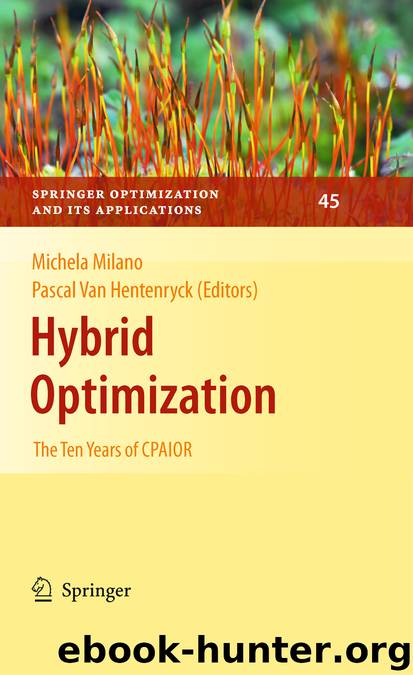Hybrid Optimization by Pascal van Hentenryck & Michela Milano

Author:Pascal van Hentenryck & Michela Milano
Language: eng
Format: epub
Publisher: Springer New York, New York, NY
4 Local Search for Pruning and Propagation
LS has been used as a means of demonstrating that the current partial solution to a problem has no legal extension (resulting in pruning) or that certain value assignments cannot be made in any legal extension (resulting in domain filtering, or propagation as it is also known). Although this area has not been widely explored, this section describes some pieces of work which have successfully used LS to reduce search tree size through pruning and/or propagation.
In [96], Harvey and Sellmann describe how to increase pruning and propagation on the Social Golfer Problem. The social golfer problem can be stated as follows: 32 golfers want to play in 8 groups of 4 each week for 9 weeks, such that no pair of players play together more than once. Is this possible? The problem can be generalized to one of determining a w week schedule of g groups of golfers, with each group of size s. Harvey and Sellmann’s method depends on finding witnesses to the insolubility of the current sub-problem. These witnesses are clique structures contained in a residual graph representation of the sub-problem.
Consider that a golfing schedule is being built week by week, in chronological order, and that a graph is maintained in which each golfer is represented by a node and a pair of golfers that have already played together in previous weeks is represented by an arc connecting their respective nodes. If a clique of size k is present in this graph, then it means that the golfers involved in the clique must play in different groups from now on. If, when scheduling the current week by building groups for that week, we get to a situation where none of the golfers in the clique have been scheduled, but less than k groups remain available this week, then the current partial assignment cannot be completed as each of the k golfers in the clique must be put into a different group. Harvey and Sellmann use an extension of this pruning rule to perform propagation and describe an orthogonal rule which reasons on golfers rather than on groups in a week. The authors use a randomized LS approach with intensification and diversification steps to find the cliques. Results show that significant gains can be made both in terms of number of backtracks and run time.
Focacci and Shaw [30] present a method for pruning the search tree based on the application of a dominance rule, the detection of the rule’s applicability at any node being carried out by a LS process. The method could be considered an implementation of Symmetry Breaking by Dominance Detection [26, 29]. Focacci and Shaw argue that aggressive pruning of a search tree by dominance rules can be detrimental to the success of a search algorithm. For example, consider a Euclidean TSP where a 2-opt [59] dominance rule is applied. That is, any branch of the search tree which constructs a partial tour where two arcs cross (and is therefore
Download
This site does not store any files on its server. We only index and link to content provided by other sites. Please contact the content providers to delete copyright contents if any and email us, we'll remove relevant links or contents immediately.
Bad Blood by John Carreyrou(6477)
Rich Dad Poor Dad by Robert T. Kiyosaki(6318)
Principles: Life and Work by Ray Dalio(6132)
Playing to Win_ How Strategy Really Works by A.G. Lafley & Roger L. Martin(5774)
Management Strategies for the Cloud Revolution: How Cloud Computing Is Transforming Business and Why You Can't Afford to Be Left Behind by Charles Babcock(4494)
The Confidence Code by Katty Kay(4158)
Thinking in Bets by Annie Duke(4121)
American Kingpin by Nick Bilton(3711)
Delivering Happiness by Tony Hsieh(3332)
Project Animal Farm: An Accidental Journey into the Secret World of Farming and the Truth About Our Food by Sonia Faruqi(3139)
The Power of Habit by Charles Duhigg(3021)
The Tyranny of Metrics by Jerry Z. Muller(2955)
Mastering Bitcoin: Programming the Open Blockchain by Andreas M. Antonopoulos(2951)
Brotopia by Emily Chang(2947)
The Marketing Plan Handbook: Develop Big-Picture Marketing Plans for Pennies on the Dollar by Robert W. Bly(2902)
I Live in the Future & Here's How It Works by Nick Bilton(2900)
The Content Trap by Bharat Anand(2837)
Applied Empathy by Michael Ventura(2811)
Building a StoryBrand by Donald Miller(2807)
